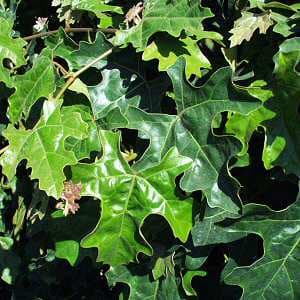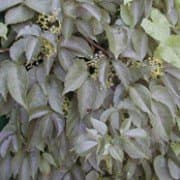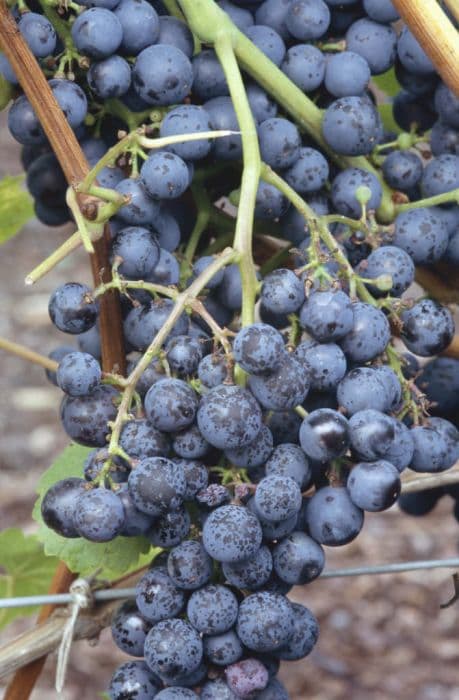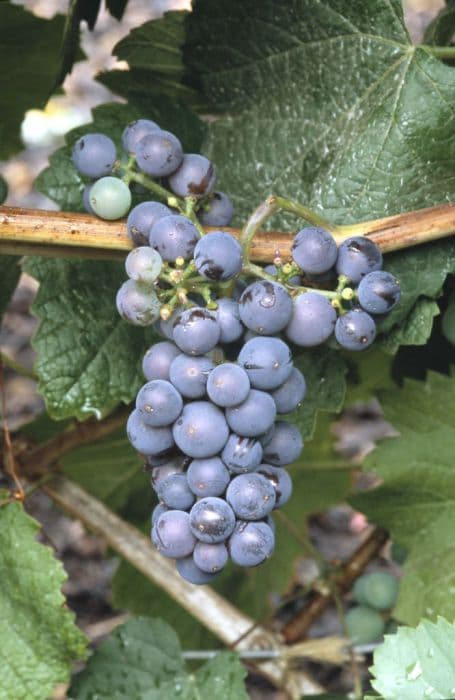Cape Grape Rhoicissus capensis

ABOUT
The plant widely known as the Cape Grape features a climbing or trailing habit that enables it to spread across various surfaces for support. It bears lush and glossy green leaves that are oval to heart-shaped, often with a leathery texture which adds a robust visual appeal. The foliage typically presents itself in a grouped arrangement of three leaflets, which together form a compound leaf structure, resembling a grapevine, which is a part of its common name's inspiration. Throughout the seasons, the Cape Grape may produce small clusters of inconspicuous yellowish or greenish flowers. These blooms are not particularly showy and are often overlooked in favor of the plant's attractive foliage. Following the flowering stage, the Cape Grape can bear small, round fruits that resemble miniature grapes in appearance. These fruits, which often emerge in shades of purple-black when ripe, provide an additional point of interest, although they are not widely regarded for any culinary value. The plant's stems can be slender and flexible, allowing the Cape Grape to climb with the help of tendrils that enable it to grip onto structures. Its tendrils are a critical feature that allow for attachment to various surfaces and other plants for support as it grows. This climbing attribute, combined with its attractive foliage and fruit, makes the Cape Grape a favored choice for use in ornamental gardening, particularly for those looking to cover trellises, arbors, or walls with greenery.
About this plant
 Names
NamesFamily
Vitaceae
Synonyms
Cape Grape, Bush Grape, Mountain Grape, Baboon Grape
Common names
Rhoicissus digitata, Rhoicissus tridentata, Rhoicissus tomentosa, Cissus capensis, Vitis capensis.
 Toxicity
ToxicityTo humans
The Rhoicissus capensis, commonly known as the Cape Grape, is not known to have significant toxicity to humans. Most reports indicate that it is generally safe, and there is no widespread documentation of poisonous effects from ingesting this plant. However, as with any plant, individual allergies or sensitivities can occur, so it is always wise to exercise caution and avoid ingesting plants that are not commonly recognized as edible.
To pets
The Cape Grape (Rhoicissus capensis) is not commonly listed among toxic plants for pets. While there is limited specific information on its effects on pets, there are no significant reports of toxicity in animals such as cats and dogs. However, ingestion of non-food plants can sometimes cause gastrointestinal upset in pets, so it is generally advisable to prevent your pets from eating ornamental plants. If you suspect your pet has ingested this plant and is showing symptoms of distress, consult your veterinarian.
 Characteristics
CharacteristicsLife cycle
Perennials
Foliage type
Evergreen
Color of leaves
Green
Height
10 feet (3 meters)
Spread
6 feet (1.8 meters)
Plant type
Climber
Hardiness zones
9
Native area
South Africa
Benefits
 General Benefits
General Benefits- Ornamental Value: Rhoicissus capensis, commonly known as the Cape Grape, is used for its decorative foliage and grape-like clusters of berries, adding beauty to gardens and landscapes.
- Shade Provider: The plant's dense growth habit makes it an excellent natural shade provider in gardens or on patios.
- Erosion Control: Its vigorous climbing and ground-covering capabilities help stabilize soil and prevent erosion on slopes.
- Habitat for Wildlife: The berries of the Cape Grape provide a food source for birds, while its foliage offers shelter and nesting opportunities.
- Drought Tolerance: Once established, the Cape Grape is drought-tolerant, making it suitable for xeriscaping and low-water landscapes.
- Screening Plant: It can be used to create a living screen, offering privacy and reducing noise from outside sources.
- Low Maintenance: Rhoicissus capensis requires minimal care once established, making it an ideal plant for gardeners seeking low-maintenance options.
 Medical Properties
Medical Properties- Anti-inflammatory: Rhoicissus capensis has been traditionally used for its anti-inflammatory properties, which may help in reducing swelling and pain.
- Antioxidant: The presence of phenolic compounds in this plant suggests it might have antioxidant benefits, helping to neutralize harmful free radicals in the body.
- Analgesic: There is some traditional use of Rhoicissus capensis for its pain-relieving effects.
- Wound healing: The plant has been used in traditional medicine to promote the healing of wounds.
- Antimicrobial: Some studies suggest that Rhoicissus capensis may have antimicrobial properties, which could be beneficial in fighting infections.
 Air-purifying Qualities
Air-purifying QualitiesThis plant is not specifically known for air purifying qualities.
 Other Uses
Other Uses- Rhoicissus capensis, commonly known as the "Cape Grape," can be trained to climb on trellises and arbors as an ornamental plant, providing aesthetic appeal and shade in gardens and patios.
- The plant's dense foliage can be used as a screen for privacy in residential gardens or on balconies.
- Its ability to cascade makes the Cape Grape suitable for hanging baskets, adding greenery to indoor and outdoor spaces at different levels.
- Creative landscaping uses include crafting green curtains or walls with the Cape Grape to create natural partitions in large open spaces like conservatories.
- The leaves of Rhoicissus capensis could be used in floral arrangements as a filler to add lush, green textures to bouquets and centerpieces.
- The robust tendrils and stems of Cape Grape can be incorporated into natural art installations or living sculptures in public spaces or art galleries.
- When dried and treated, the vine wood from mature plant growth can be used for crafting small decorative items such as picture frames or woven panels.
- The Cape Grape can act as a host plant for certain species of butterflies, supporting biodiversity in a garden setting.
- In themed gardens, such as those designed to imitate a Mediterranean landscape, the plant can contribute to the authenticity of the design with its grape-like appearance.
- During festive seasons, the thick foliage of Rhoicissus capensis can be decorated with lights and ornaments to create a natural holiday decor element.
Interesting Facts
 Feng Shui
Feng ShuiThe Cape Grape is not used in Feng Shui practice.
 Zodiac Sign Compitability
Zodiac Sign CompitabilityThe Cape Grape is not used in astrology practice.
 Plant Symbolism
Plant Symbolism- Resilience - Rhoicissus capensis, commonly known as the Cape Grape, is a hardy climbing plant that can survive in variable conditions, symbolizing the ability to overcome adversity and bounce back.
- Growth and Expansion - As a vigorous climber, the Cape Grape is often associated with growth and the expansion of ideas or projects.
- Protection - With its dense foliage, the Cape Grape provides shelter and is thus reminiscent of safety and protection.
- Adaptability - This plant can adapt to both indoor and outdoor environments, symbolizing the capability to thrive in different situations or phases of life.
 Water
WaterThe Cape Ivy should be watered when the top inch of soil feels dry to the touch, typically once a week, but this may vary with the humidity and temperature of the environment. Use room temperature water, and apply enough water to moisten the soil thoroughly until it begins to drain from the bottom of the pot; this may be around half a gallon for a medium-sized pot every time you water. During winter months, reduce the frequency of watering as the plant's growth slows down. Be cautious not to overwater as Cape Ivy is sensitive to soggy soil conditions, which can lead to root rot.
 Light
LightCape Ivy prefers bright, indirect light to thrive. It's best placed in a location where it can receive plenty of sunlight without being directly exposed, like near a window with a sheer curtain providing a light filter. Avoid direct hot sunlight as it can scorch the leaves. This plant can also adapt to lower light conditions, but its growth may slow down as a result.
 Temperature
TemperatureThe ideal temperature range for Cape Ivy is between 65 and 80 degrees Fahrenheit. Avoid exposing the plant to temperatures below 50 degrees Fahrenheit, as cold drafts can damage the plant. Cape Ivy is not frost-tolerant and should be kept away from cool windows in the winter to maintain its health and growth.
 Pruning
PruningCape Ivy should be pruned to maintain its shape, control its size, and encourage fuller growth. Trim as needed throughout the year, focusing on leggy or overgrown stems. The best time for a major pruning is in the early spring before new growth begins. Regularly removing dead or damaged leaves and stems also keeps the plant healthy and looking its best.
 Cleaning
CleaningAs needed
 Soil
SoilThe Cape Ivy prefers a well-draining, loamy and fertile soil with added organic matter. The best soil mix can be created with two parts potting soil, one part perlite or sand, and one part compost or peat. The ideal pH for the Cape Ivy should be slightly acidic to neutral, around 5.5 to 7.
 Repotting
RepottingThe Cape Ivy should be repotted every two to three years to replenish its soil and accommodate the growth of its roots. However, frequent repotting is not necessary unless the plant has outgrown its current container.
 Humidity & Misting
Humidity & MistingThe Cape Ivy thrives in moderate to high humidity levels, ideally between 40% to 60%. It can tolerate lower humidity but consistent levels within the optimal range will ensure healthy growth.
 Suitable locations
Suitable locationsIndoor
Place Cape Ivy in bright, indirect light and maintain humidity.
Outdoor
Grow Cape Ivy in part shade with shelter from harsh sun.
Hardiness zone
10-11 USDA
 Life cycle
Life cycleCape Grape, also known as Rhoicissus capensis, starts its life as a seed, which upon germination, develops a primary root that anchors it in the soil and allows the plant to absorb water and nutrients. The seedling then produces cotyledons, or seed leaves, that provide initial energy before the true leaves develop. As the plant matures, it grows into a robust climbing vine, using tendrils to attach to supports. The Cape Grape will eventually produce clusters of small, inconspicuous flowers that, upon pollination, can develop into small, non-edible berry-like fruits. Over time, the vine can become woody, and as a perennial, it will go through cycles of growth and dormancy, often corresponding with seasonal changes. The vine's extensive growth enables it to spread and, under ideal conditions, can be quite vigorous, necessitating regular pruning to control its size.
 Propogation
PropogationPropogation time
Spring-Early Summer
Rhoicissus capensis, commonly known as the Cape Grape or Baboon Grape, is a plant that is often propagated through stem cuttings. The most popular method involves taking semi-hardwood cuttings during late spring or early summer, when the plant is actively growing. Cuttings should be about 4 to 6 inches long, with several leaves left on the upper part and the lower leaves removed. The cut end of the cutting should be dipped in a rooting hormone to encourage root development. Then, the cutting is planted in a well-draining soil mix and kept under warm, humid conditions until roots have established, which typically takes several weeks. Regular misting can help maintain the necessary humidity. Once the roots are established, the new plants can be transplanted into individual pots or into the garden.




![Grape [Claret Cloak]](/_next/image?url=https%3A%2F%2Fplants-admin.emdemapps.com%2Fimages%2Fplants%2F%2Fimages%2F604b602abe2f8.png&w=640&q=75)




